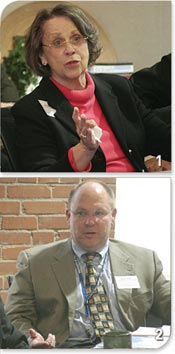All agreed that plant science can and should be a critical part of the life science movement, which led to a discussion of perhaps the most promising development for the region in that regard.
“I saw a map recently provided to me by the Department of Commerce in Kansas,” said Bill Duncan, “that had all of the production facilities for ethanol and bio-diesel and all those planned and I could not believe it. I couldn’t even count them all.” He added that Missouri is equally rich in these facilities. “Where do you think this is headed?” he asked.

1: Lesa Mitchell of the Kauffman Foundation discussed the importance of recruiting top-notch scientists to the Kansas City area. Jeff Southard of VasoGenix Pharmaceuticals observed.
2: MO Bio Executive Director Kelly Gillespie discussed the importance of uniting organizations in the bi-state region.
“We think it plays to a lot of Midwest natural strengths,” said John Gardner. Gardner referred specifically to the area’s rich combination of agriculture and life science. He made the salient point, however, that if we were to consciously plan to “produce bio-energy from the sun using plants as a converter,” we would design a bio-system unlike the one that currently resides on the agricultural landscape.
“I think we would have a totally different solution,” said Gardner. “That is the long-term horizon that is exciting for the Midwest, for the expertise that resides in our institutions, and our expertise in the business sector as well.”
In addition to the ethanol production from sugars and carbohydrates, Jake Halliday observed that there appears to be an emerging federal funding opportunity in cellulosic fermentation. “These plants are already commercial and successful and they work,” said Halliday, but he cautioned that the cellulosic is a bit more challenging to do economically.
“I think that’s the whole problem for any company right now,” commented Jeff Biskup. “We are a long way from the real answer. We are burning more energy making it than we are getting out.”
Although Kelly Gillespie expressed concern about farmers too eagerly embracing these technologies and putting their own money into plants that might fail, he saw a real benefit to the life science movement. “Suddenly in the capital,” he says, “biotechnology equals the destruction of embryonic stem cells has been moved to biotechnology is something that is good for farmers, good for consumers, good for sustainable energy. It’s a big positive.”
Sustainability
Joan Hunt asked the day’s final question of chair Bill Duncan on how the KCALSI hoped to “maintain the level of enthusiasm” the area has seen over the last six years.
“I the early days,” said Duncan, “when we tried to facilitate collaboration amongst the scientists, that was pretty hard. Herding those cats was not easy. Nowadays, it’s a lot easier.”
“We don’t do as much hand-holding as we used to from my perspective,” Duncan continued. “So I think that’s good. You know, I honestly believe sustainability is directly proportional to resources available. If those resources are real, and I think they are, I have to tell you I am as excited and encouraged, more than I have ever been as far as the success of this initiative on a regional basis.” ![]()